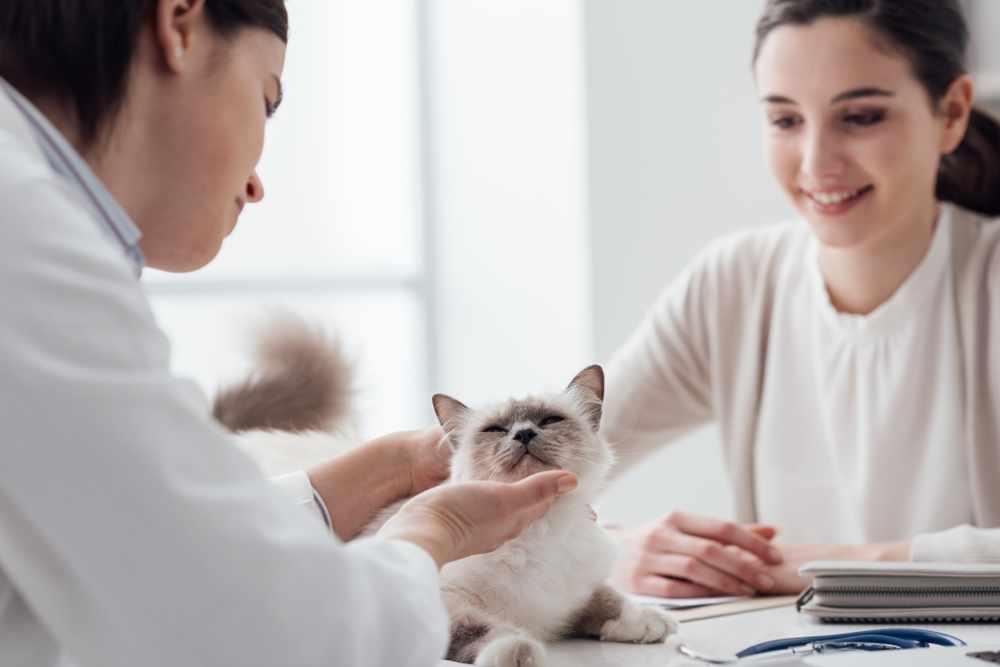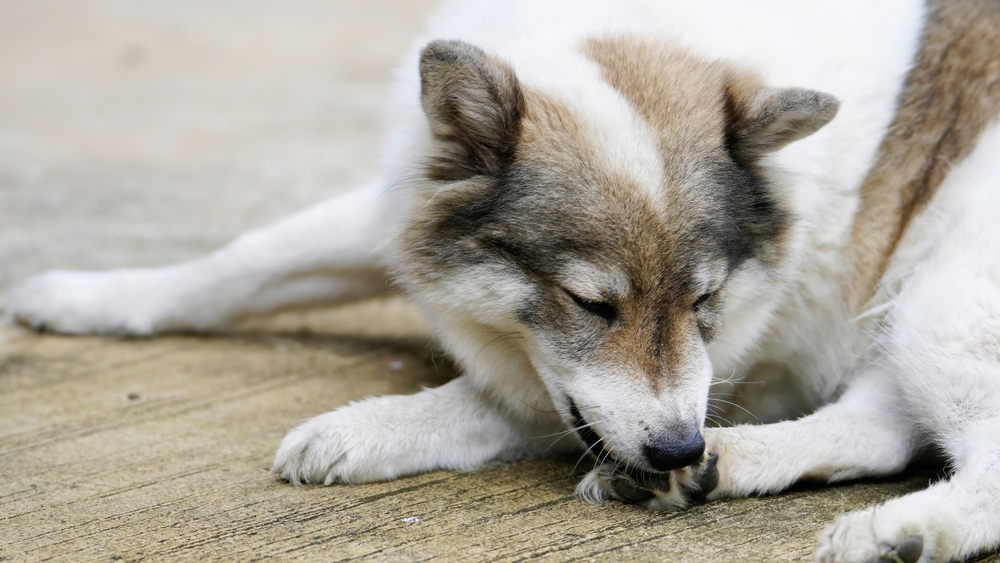Grooming is a natural animal behavior that supports your pet’s health and hygiene, but excessive or over-grooming can signal a deeper problem. If your pet is grooming obsessively or targeting a specific area, check out this grooming guide from Groves Veterinary Clinic.
That fresh clean feeling—grooming benefits for pets
Cats are known for their fastidious grooming. Our feline friends groom themselves up to half their waking hours (i.e., roughly 3.6 hours per day). Dogs also routinely groom themselves, although not to the same commitment level as cats.
Most self-grooming behaviors are oral (e.g., biting, nibbling, licking the skin and coat), or involve the paws (i.e., cats cleaning their face or ears), or the full body (e.g., rubbing, rolling, or shaking off). These behaviors serve a valuable purpose for pets, including:
- Skin and coat maintenance — Grooming removes dead hair and debris, prevents matting, and aids in natural oil distribution.
- Parasite removal — Licking or nibbling can remove external parasites (e.g., fleas and ticks).
- Temperature regulation — Cats lick their skin and coat to achieve evaporative cooling.
- Stress relief and comfort — Grooming stimulates a soothing endorphin release. Dogs may groom to reduce tension and prevent a conflict with an assertive or dominant dog. Grooming behaviors that are displayed suddenly and in an unnatural context are known as displacement behaviors.
How much is too much? Excessive grooming signs in pets
Like all good things, frequent or intense grooming can have serious consequences. Excessive grooming signs in pets include:
- Hair loss
- Intense or prolonged biting, chewing, or licking on the body
- Visible skin irritation or inflammation (i.e., redness)
- Consistently wet coat
- Interruptions in normal behavior (e.g., eating, sleeping, or exercising) to bite, chew, or lick
- Crying or whining while grooming
- Targeted or hyper-focused grooming that concentrates on one area
- Skin ulceration, discharge, or sores
- Interrupted sleep or wake cycles
Because excessive grooming can indicate an underlying problem and lead to further complications, veterinary attention is always recommended.
5 reasons why your pet may be over-grooming
Your pet’s healthy grooming routine can become harmful for many reasons, so excessive grooming requires veterinary care. Your veterinarian can pinpoint the cause and provide effective solutions that will soothe your pet and break the vicious over-grooming cycle.
Here are five common reasons why your pet’s self-care can become self-sabotage.
- Allergies — Allergic skin disease (i.e., atopy, or atopic dermatitis) is an inflammatory immune system response caused by allergen exposure. Pets express most allergies through their skin rather than the upper respiratory tract, like humans, and will intensely scratch, bite, and lick to relieve their discomfort. Allergens vary by pet and may include pollens, grasses, dust, mold, medication, and foods.
- Stress — Grooming is a self-soothing activity that pets may use to relieve boredom, anxiety, or nervousness. Then, the positive response may cause over-grooming to become an obsessive-compulsive habit for these pets.
Cats are especially stress sensitive, especially in multi-cat households. For example, feline psychogenic alopecia, a behavior-based dermatological condition, leads to hair loss along the abdomen, inner thighs, groin, and mid-back.
Pets with stress-induced excessive grooming may benefit from behavior-modifying medications, environmental management, and removal of stressful triggers—however, all medical causes and pain must be ruled out or alleviated before attempting behavior-based anxiety treatments.
- Pain — Excessive grooming in one area commonly indicates pain or discomfort, especially when the target area is over or near a joint. In addition to endorphin release, grooming may temporarily relieve or distract from the pain, similar to how we rub a sore elbow or apply pressure to an aching knee.
- Parasites — Fleas, ticks, and mites bite and burrow into the pet’s skin, causing local irritation and inflammation. Irritated pets may groom excessively to remove one or more parasites from their skin and coat. For some pets, a single flea bite can trigger a severe allergic reaction (i.e., flea allergy dermatitis [FAD]), which is characterized by intense biting, scratching, and hair pulling, often around the tail base.
- Nausea — Nauseated pets may try to find relief by licking their paws, limbs, or abdomen repeatedly, eating grass or attempting to pull up carpet or bedding, smacking their lips, or repeatedly stretching in a play bow or praying position. If their nausea doesn’t subside, pets may follow these behaviors with inappetence, vomiting, diarrhea, or lethargy.
Talk to your veterinarian about your pet’s excessive grooming

Excessive grooming is a strong indicator that your pet isn’t feeling well and that the cause—and solution—are likely more than skin deep. Your veterinarian will ask you to describe your pet’s behavior and any changes in their environment and will then perform a nose-to-tail examination to look for signs and insights into a possible cause. Additional diagnostic testing will likely be necessary to confirm or rule out potential diagnoses. Possible tests include:
- Skin assessment and cytology
- Blood work
- Orthopedic assessment
- Imaging (e.g., X-rays, ultrasound)
Depending on your pet’s diagnosis, our veterinary team will provide a personalized treatment plan focused on addressing the cause, relieving your pet’s discomfort, and restoring their physical and emotional wellbeing.
Grooming is a beneficial part of your pet’s daily care routine, but obsessive or frantic behaviors can do more harm than good. If your pet is excessively licking, biting, or chewing their skin and coat, contact Groves Veterinary Clinic to schedule an examination.







